The
right technologies for decarbonisation of heating
Commercial Solutions
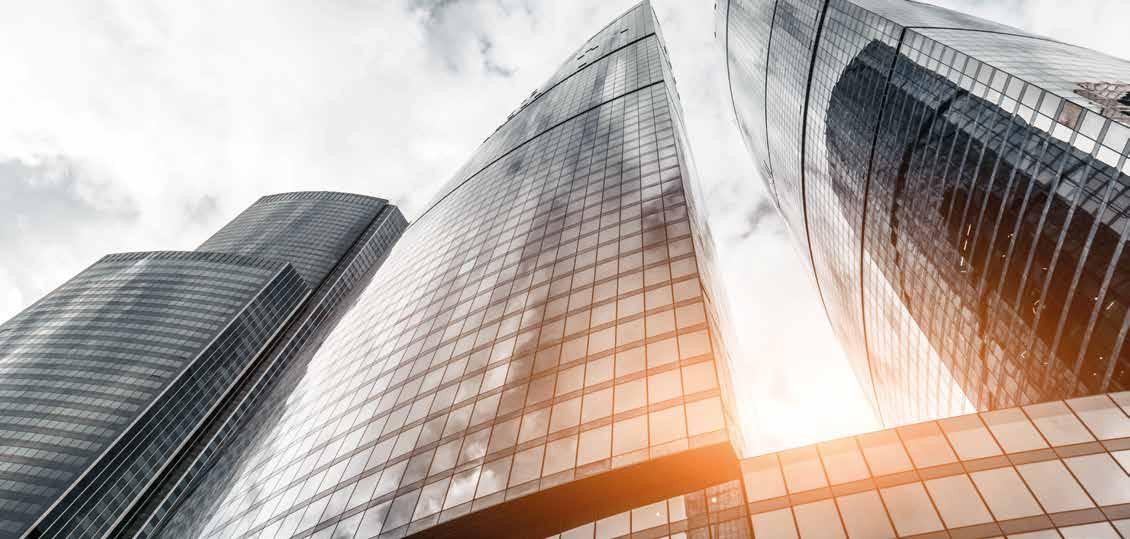
Heat Pump
Table of Content
Introduction to decarbonisation page 4
Reducing CO 2 foot print with Heat Pumps page 5
Heat Pump Classification page 6-7
Daikin‘s Heat Pump solutions
page 8-11
European Outlook on Decarbonisation
In 2020 the EU Commission published the strategy “A Renovation Wave for Europe – Greening our buildings, creating jobs, improving lives” to boost renovation in the EU. It aims to double annual energy renovation rates in the next 10 years in order to reduce emissions by decarbonising heating and cooling as one of the key focus actions.

REPowerEU
A plan to rapidly reduce dependence on Russian fossil fuels and fast forward the green transition:
On 18.05.22, the EU Commission launched their plan to reduce dependency to Russian fossil fuels. One of the key actions planned is to accelerate the shift to renewable energy sources. This also includes the ambitious target of doubling the rate of deployment of heat pumps.
Greenhouse Gas Emissions
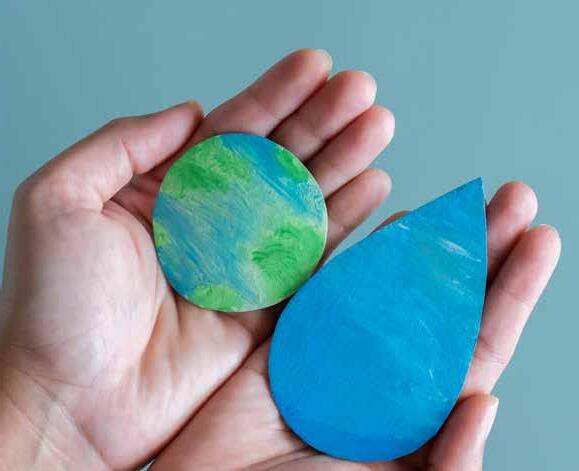
Based on 2020 data, the manufacturing industries, commercial applications, institutions & households are responsible for one of the highest greenhouse gas emissions in the EU (27,5%).
Inefficient building stock is still responsible for 50% of the EU’s total energy consumption and for 36% of its greenhouse gas emissions.
Source:
3 Transport 23,2% Households, Commerce, Institutions 15,4% Manufacturing, Construction 12,1% Energy industry 23,3% Fuels fugitive emissions 1,8% Industrial processes and product use 9,4% Agriculture 11,4% Waste management 3,3% Fuel combustion 74% Other 24,2%
Business travel and employee commuting Transportation and distribution
Franchises
Greenhouse Gas (GHG) Protocol Corporate Standard:
The GHG Protocol Corporate Standard categorizes greenhouse gas emissions associated with a company’s Corporate Carbon Footprint (CCF) as Scope 1, Scope 2, and Scope 3 emissions.
Scopes and 2 encompass various actions to reduce the CO footprint of the companies such as the energy consumption reductions & transition to more green energy sources (i.e. electrification).
Scope 1
Possible actions to reduce CO 2 footprint linked to Scope 1 & 2
Leasing of assets
Investments Fuel and energy related activities
Purchased goods and services
End of life treatment of sold products
Purchased heating, steam and cooling
Purchased electricity
Direct emissions from company’s facilities
Direct emissions from company’s vehicles
Scope emissions include direct emissions from the company’s owned or controlled sources.
Scope 2
Scope 2 emissions include indirect greenhouse gas emissions from purchased or acquired energy, like electricity steam, heat, or cooling, generated off-site and consumed by your company.
Scope 3
Scope 3 includes all indirect emissions that occur in the value chain of a reporting company.
Reducing energy consumption on facilities
Replace, retrofit or optimise the existing equipment, appliances & systems for a more efficient operation. Limit unnecessary energy usage on site.
Producing energy on-site
Renewable energy production technologies set-up on site to produce clean energy (eg. PV panels, wind turbines…)
Scope 1 Direct
European Union (EU) Climate Target Plan 2030
Scope 2
Indirect
Reduce net greenhouse gas emissions by 55% by 2030*
Scope 3
Indirect
*Compared to the 1990 levels
Transition to electrification
Process of replacing technologies that use fossil fuels (coal, oil, and natural gas) with technologies that use electricity as a source of energy.
Example: implementation of heat pump technologies for heating & cooling requirements of the site – limiting the boiler (e.g. fossil fuel) usage.
Renewable energy procurement

A method of tracking the actual amount of electricity produced from renewable energy resources. By buying renewable energy contracts, companies can effectively offset their own electricity consumption by purchasing an equivalent amount of electricity produced by renewable resources.
Off-setting
Any reduction of greenhouse gas (GHG) emissions to make up for emissions that occur elsewhere.
5
A B C D
Reducing CO 2 footprint with Heat Pump technology
The electrification of heat through heat pumps, where the electricity to drive the heat pumps comes from renewable sources, is seen as a key technology in cutting carbon emissions.
Heat ~0,95
Heat Pump Classification
Air-to-air heat pumps
ʯ Can provide heating, cooling and sanitary hot water.
ʯ Heat is transferred between the building and outside air using refrigerant gas.
ʯ Heating and cooling is done via indoor terminal units that are blowing air, rather than traditional radiators.
Water-to-water heat pumps
ʯ Can provide heating, cooling and sanitary hot water.
ʯ Heat is transferred between the building and various energy sources (e.g. geothermal, outdoor air, etc.) using a refrigerant gas & water.
ʯ Can reach very high temperatures to even replace boiler solutions to serve radiators or process heating applications.
Air-to-water heat pumps
Can provide heating, cooling and sanitary hot water. Heat is transferred between the building and outside air using a refrigerant gas & water. Can reach high enough water temperatures to serve the needs of most applications.
Fuel 1 Traditional boiler systems
The efficiency of a boiler is usually expressed in terms of percentage. For instance, if a boiler is said to be 95% efficient, then 95% of the gas energy comes out as useful heat to water, and 5% is lost as heat out of the flue.
1kW
Heat 4 kW
Heat Pumps

Heat pumps can transfer the free heat energy even from cold ambience, ground or other possible sources to the building. While doing this, heat pumps utilise electricity (i.e. power input) which is usually much lower than the heat energy that is transferred to the building.

7
Tank Tank 3 kW free energy ambient air
Heat pump solutions for Boiler Replacement

The majority of the buildings in Europe still utilise gas boilers as the main heating source. EU decarbonisation targets and the uncertainty within the gas price market are making the heat pumps one of the most viable solutions to reducing both the CO2 footprint and dependency on gas.
Based on the building’s heating load requirements Daikin can offer various heat pump system solutions.
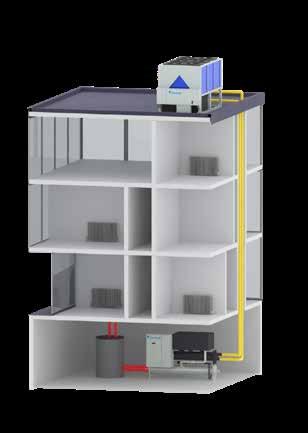
Single
A stand-alone heat pump solution can be recommended for buildings with a relatively good insulation. With better insulated buildings, less heat losses will occur therefore the heating demand can be satisfied with lower water temperatures between 45°C and 60°C.
Cascade
For older buildings without any insulation retrofit plans, higher water temperatures might be required to match the water temperatures provided by the existing boiler solution. Daikin can provide up to 75°C within a cascade solution where the air-to-water and a water-to-water heat pump units operate together.
Boiler Replacement
Decarbonisation effect
Reducing CO2 emissions is the common goal of almost every company with ambitious sustainability goals. It is a known fact that CO2 emissions can be greatly reduced thanks to both the higher efficiencies of the heat pump technology and the lower emission factors of electricity grids in comparison to the gas boilers’.

Cost - Benefit Analysis
There are various other actions which can be taken to reduce CO2 emissions. The balance between the investment costs and the achievable CO2 reductions is a key decision criterion.
“Marginal Abatement Cost Curve (MACC)” is a common tool used by the industry to plan & prioritize their CO emission reducing investments.
(Calculation above is based on the 70°C water temperature supply both for boiler and the heat pump)
8.981
Replacing your existing fossil fuel driven boiler systems with a heat pump or upgrading your HVAC equipment could yield significant CO2 emission reductions with an acceptable €/tCO e ratio, as well as a reasonable return on investment period.
11 10
Case 1 - Process Heating Gas Boiler Heat Pump Heating Demand (kwh) 46.123 Boiler efficiency / Heat pump COP 95% 2,3 Emission factor (g/kwh) 185 125 CO2 emission in tons 8.981 2.658 Note: Project life time is considered as 15 years Boiler Replacement
Heating
45.588 kWh - Annual
Demand
tons CO 2 emission 2.658 tons CO emission Standard Boiler Solution
Daikin Solution
Return on investment
Height of each bar shows the net resource cost of the abatement option Width of each bar shows the abatement potential (i.e. quantity of emissions reductions available) Boiler replacement with a HP HVAC efficiency improvement Solar energy Wind energy Other process adjustments Photovoltaic Return on investment is longer than the defined project life cycle Abatement potential tCO e Marginal abatement cost €/ tCO 2 e
is shorter than the defined project life cycle
case:
Sample
VRV
Daikin Solutions





Commercial solutions from small to large applications
Scroll compressor 12- 150 kW OAT down to -25°C
Different kind of commercial applications can be managed by Daikin heat pumps which can guarantee operation down to -20°C outdoor ambient temperature.
Rooftop
EWWQ-KC Scroll compressor 14 - 64 kW CLWT up to 55°C
EWHQ-G/ EWWQ-G/ EWWQ-L
Screw compressor 91 - 390 kW CLWT up to 55°C



EWWD(H)(S)-J
R-134a
EWWD(H)(S)-VZ
Water to Water
Scroll compressor 25 - 190 kW OAT down to -20°C
Air to Air
Heat Pumps

Overview
EWYA-DV3(W1)P Mini Chiller



Swing compressor 4 - 16 kW
OAT down to -25°C
CLWT up to 65°C
Air to Water
EWYT-B
Altherma A2W, Hybrid, Geothermal




R-134a
EWYT-CZ
EWYD-BZ
EWYD-4Z
R-134
Hermetically sealed swing/ scroll compressor
4kW - 18kW
OAT down to -28°C
LWT up to 80°C
Scroll compressor 16 - 90 kW OAT down to -20°C
Screw compressor 250 - 580 kW
OAT down to -20°C
CLWT up to 55°C
Screw compressor 107 338 kW CLWT up to 75°C
R-134a
R-1234ze R-1234ze
Screw compressor 329 2074 kW CLWT up to 75°C
R-513A R-513A
R-134
Screw compressor 250 580 kW
OAT down to -20°C
CLWT up to 55°C
R-134
Screw compressor 400 - 800 kW
OAT down to -10°C
CLWT up to 65°C
13 12
Hotel Home Store & Shop Bank Office Sport & Leisure Restaurant Industry Technical Condenser leaving water temperature range Outdoor Ambient Temperature 40 °C -20 °C +45 °C 75 °C
Heat
Air to Air heat pump VRV solution

Daikin VRV solutions provide the best air-to-air comfort for cooling, heating & sanitary hot water requirements while offering major energy savings compared to the traditional boiler systems.
Key Benefits
ʯ Stable heating capacities & minimal defrost cycles even down to -15°C during winter
ʯ Fully integrated solution with heat recovery for maximum efficiency with COPs of up to 8!
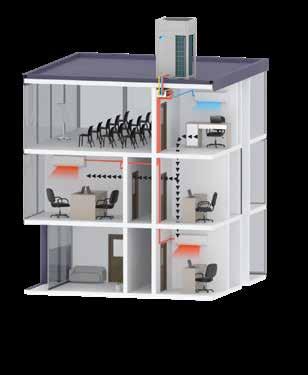
ʯ “Free” heating and hot water production provided by transferring heat from areas requiring cooling to areas requiring heating or hot water production
ʯ The perfect personal comfort for guests/ tenants via simultaneous cooling and heating
ʯ Unique continuous heating technology makes VRV IV the best alternative to traditional heating systems - ensuring continuous comfort
Heat pump solutions
Air to water heat pump solution


Daikin‘s air to water heat pump is the ideal solution for buildings where high efficiency comfort cooling & heating is a main requirement.
Key Benefits
ʯ Top class efficiency: SEER up to 5,76, SEPR up to 8,48 and SCOP(AW35) up to 4,197
ʯ Extended capacity range: possibility to connect up to 4 units working as single system up to 4x90 kW

ʯ Daikin design inverter scroll compressors for hot water production up to 60 ° C
ʯ Inverter pump kit option with both low and high lift available
ʯ Heating operation down to -20°C
ʯ High efficiency Daikin design inverter fans with a selectable silent mode

ʯ One or two independent refrigerant circuits with one or two inverter scroll compressors
ʯ Sanitary hot water feature available
ʯ Split version is ideal for colder climates applications: hydronic module can be installed inside eliminating the need for glycol.
ʯ Compact dimensions allowing installation in very restricted spaces
15 14
pump solutions
VRV IV+ RXYQ-U & REYQ-U EWYT-CZ Cooling Capacity (kW) Cooling Capacity (kW) Cooling Capacity (kW) Cooling Capacity (kW) Heating Capacity (kW) Heating Capacity (kW) Heating Capacity (kW) Heating Capacity (kW) 22 16 150 90 22 21 22 16 150 90 25 21 80 64 90 64 VRV 5 Heat Recovery REYA-A EWYT-CZI + EWYT-CZO Reducing heating costs up to 30%! *Operating range may vary by model *CLWT: condenser leaving water temperature; OAT: outdoor ambient temperature Outdoor ambient temperature (*) Water temperature Operating range Cooling Operations Heating Operation Sanitary hot water production 45 °C 15 °C 80 °C -20 °C -20 °C 25 °C Outdoor ambient temperature Water temperature Operating range Cooling Operations Heating Operation Sanitary hot water production 45 °C 35 °C Up to 80 °C -20 °C -20 °C Low environmental impact R-32 refrigerant GWP 675 Low environmental impact R-32 refrigerant GWP 675 Scan code for AR experience Heating water temperatures* CLWT (°C) OAT (°C) -20 47°C 30 54°C 10 60°C 0 57°C -10 52°C
Heat pump solutions
Cascade heat pump solution for high water temperatures
A Daikin cascade system consists of a solution with an air cooled and a water cooled unit operating together to achieve high leaving water temperatures and therefore is suitable also for refurbishment projects.
Key Benefits
ʯ Complete heat pump system (no gas boiler or district heating required)




ʯ Able to produce up to 75 °C water temperature at -20 °C outdoor ambient temperature
ʯ Suitable for Comfort and Process applications

ʯ Possibility of heat or cold energy recovery in all operating conditions
ʯ High efficiency
ʯ Low GWP refrigerants (R-32 & R-1234ze)


ʯ Ideal for boiler replacement due to the high temperatures reachable and compactness of water to water heat pump
Heat pump solutions


Air to water heatpump with integrated heat recovery feature
Daikin‘s air to water multipurpose unit is the best solution for buildings with all-year-round simultaneous cooling and heating requirement.

Key Benefits
ʯ Top class efficiency: TER (Total Energy Ratio) up to 8.8
ʯ Single screw compressor with refrigerant cooled integrated inverter

ʯ VVR( Variable Volume Ratio) technology changes the point at which the gas leaves the compressor, and therefore the pressures at discharge will be optimal at any condition
ʯ High efficiency inverter fans with optimized geometry ensures the best ratio between airflow and power input
ʯ Two independent refrigerant circuits with two inverter screw compressors
ʯ Two heat exchangers on water side: one operating always as evaporator and one always as condenser
ʯ Large flexibility: two sound configurations
ʯ Suitable for comfort application where cooling and heating is requested all year round
ʯ Possibility of recovering energy every time there is a contemporary request for hot and cold energy
17 16
EWYT-CZ EWYT-B EWWH-J GWP 7 EWWH-VZ Heating Capacity (kW) Heating Capacity (kW) 90 300 200 1540 *Operating range may vary by model Outdoor ambient temperature (*) Water temperature Operating range Heating Operation Sanitary hot water production 35°C Up to 75 °C -20 °C Low environmental impact R-32 refrigerant GWP 675 Scan code for 3D experience Air Cooled Air Cooled Water Cooled Water Cooled
EWYD-4Z Cooling Capacity (kW) Heating Capacity (kW) 400 800 400 800 *For operation down to -15°C, please contact your Daikin representative. *CLWT: condenser leaving water temperature; OAT: outdoor ambient temperature Outdoor ambient temperature Water temperature Operating range Cooling Operations Heating Operation Sanitary hot water production 50 °C 45 °C Up to 60 °C -20 °C -10 °C Heating water temperatures* CLWT (°C) OAT (°C) -10 50°C 40 55°C 25 57°C 5 60°C 0 57°C GWP 1430








19 18
pump solutions Highly efficient communal heat pump system for entire apartment buildings Pre-heating Leaving water temperature 20-25 C Final heating Leaving water temperature up to 65 C EWYT-B R32 Heat Pump AIR-SOURCED HEAT PUMP DAIKIN ALTHERMA 3 WS WATER-SOURCED HEAT PUMP
solution with geothermal
pump solutions
solution with geothermal Generic commercial building
if it looks like an
Collective housing solution Heat
Cascade
Heat
Cascade
Better
Heat pump solutions
Air to air heat pump - Rooftop solution

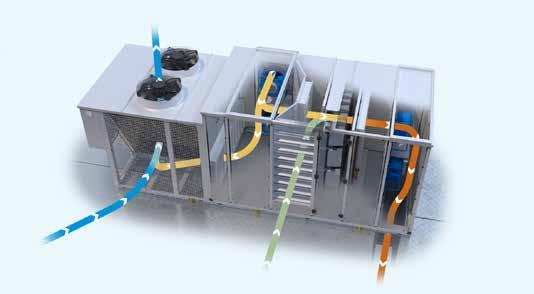


Daikin R32 rooftop provide the best plug & play heating & cooling solution for the various applications such as warehouses, industries, malls, etc. offering major energy savings compared to the traditional boiler heating systems
Key Benefits
ʯ Stable heating capacities & minimal defrost cycles even down to -20°C during winter

ʯ Fully integrated solution with heat recovery for maximum efficiency with COPs of up to 3.7
ʯ Indoor/outdoor packaged unit and factory charged refrigerant provide cost-effective installation.

ʯ High ESP up to 800Pa allows extensive ductwork to evenly distribute the air across a large space.

ʯ Scroll compressor and free cooling ensure highly efficient 24/7 operation.
ʯ Clogged filter alarm indicates when filter needs cleaning, ensuring optimum operation and minimize energy consumption.
ʯ Possible with the 4 configuration, from 100% recirculation units to plate type heat recovery fresh air comfort high IAQ operation.
21 20
*Operating range may vary by model Outdoor ambient temperature (*) Operating range Cooling Operations Heating Operation 48 °C 26 °C -10 °C -20 °C Low environmental impact R-32 refrigerant GWP 675 Scan code for AR experience Cooling Capacity (kW) Heating Capacity (kW) 25 190 25 177 Heat pump solutions Base Unit - 100% recirculation 3 damper unit – With thermodynamic heat recovery 2 damper unit – Upto 30% fresh air Upto 65% fresh air unit – With plate type heat recovery Outdoor section Return air Return air damper Supply air Fresh air damper Fresh air Return air Supply air Thermodynamic heat recovery Return air (mixing) damper Return air Supply air Bypass damper (closed) Return air (mixing) damper Extraction damper Return air Fresh air Fresh air damper Supply air Fresh air damper Fresh air Extraction damper Plate heat recovery
Daikin products are distributed by:
DAIKIN AIRCONDITIONING CENTRAL EUROPE HandelsgmbH
Lemböckgasse 59/1/1, 1230 Vienna, Austria · Tel.: + 43 (0) 1 253 21 11 · e-mail: office@daikin-ce.com · www.daikin-ce.com
Daikin Europe N.V participates in the Eurovent Certified Performance programme for Fan Coil Units and Variable Refrigerant Flow systems. Daikin Applied Europe S.P.A participates in the Eurovent Certified Performance programme for Liquid Chilling Packages, Hydronic Heat Pumps and Air Handling Units. Check ongoing validity of certificate: www.euroventcertification.com


The present publication is drawn up by way of information only and does not constitute an offer binding upon Daikin Europe N.V. / Daikin Central Europe HandelsGmbH. Daikin Europe N.V. / Daikin Central Europe HandelsGmbH have compiled the content of this publication to the best of their knowledge. No express or implied warranty is given for the completeness, accuracy, reliability or fitness for particular purpose of its content and the products and services presented therein. Specifications are subject to change without prior notice. Daikin Europe N.V. / Daikin Central Europe HandelsGmbH explicitly rejects any liability for any direct or indirect damage, in the broadest sense, arising from or related to the use and/or interpretation of this publication. All content is copyrighted by Daikin Europe N.V.
DACE Commercial Heat Pump Solutions | Version March 2023
We reserve the right for printing errors and model changes




















































